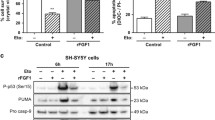Abstract
Fenretinide-induced apoptosis of neuroectodermal tumour cells is mediated through generation of reactive oxygen species (ROS), endoplasmic reticulum (ER) stress, mitochondrial cytochrome c release and caspase activation. The present study describes the requirement of the BH3-domain only protein Noxa for this process and its regulation by p53. Noxa expression was induced by fenretinide in neuroblastoma and melanoma cells, including those with mutated p53, and this induction was abolished by antioxidants. Knockdown of p53 by RNA interference (RNAi) demonstrated upregulation of Noxa protein levels in response to fenretinide was p53-independent, although evidence suggested that Noxa may be transcriptionally regulated by p53. The ER stress-inducing agent thapsigargin also induced p53-independent Noxa expression. Conversely, Noxa transcription in response to the chemotherapeutic agents cisplatin or temozolomide was inhibited by p53 knockdown. Apoptosis in response to cisplatin or temozolomide was also inhibited by abrogation of p53 expression yet apoptosis in response to fenretinide or thapsigargin was unaffected. RNAi-mediated down-regulation of Noxa inhibited apoptosis in response to fenretinide or thapsigargin, whereas apoptosis induced by cisplatin or temozolomide was unaffected. These data demonstrate the importance of Noxa induction in determining the apoptotic response to fenretinide and emphasise the role of Noxa in p53-independent apoptosis.







Similar content being viewed by others
References
Garaventa A, Luksch R, Lo Piccolo MS et al (2003) Phase I trial and pharmacokinetics of fenretinide in children with neuroblastoma. Clin Cancer Res 9:2032–2039
Corazzari M, Lovat PE, Oliverio S et al (2005) Fenretinide: a p53-independent way to kill cancer cells. Biochem Biophys Res Commun 331:810–815
Lovat PE, Ranalli M, Annichiarrico-Petruzzelli M et al (2000) Effector mechanisms of fenretinide-induced apoptosis in neuroblastoma. 260:50–60
Tiwari M, Kumar A, Sinha RA et al (2006) Mechanism of 4-HPR induced apoptosis in glioma cells: evidences suggesting role of mitochondrial-mediated pathway and endoplasmic reticulum stress. Carcinogenesis (In Press)
Amiri KI, Horton LW, LaFleur BJ, Sosman JA, Richmond A (2004) Augmenting chemosensitivity of malignant melanoma tumors via proteasome inhibition: implication for bortezomib (VELCADE, PS-341) as a therapeutic agent for malignant melanoma. Cancer Res 64:4912–4918
Michaelis M, Fichtner I, Behrens D et al (2006) Anti-cancer effects of bortezomib against chemoresistant neuroblastoma cell lines in vitro and in vivo. Int J Oncol 28:439–446
Perez-Galan P, Roue G, Villamor N, Montserrat E, Campo E, Colomer D (2006) The proteasome inhibitor bortezomib induces apoptosis in mantle-cell lymphoma through generation of ROS and Noxa activation independent of p53 status. Blood 107:257–264
Fernandez Y, Verhaegen M, Miller TP et al (2005) Differential regulation of noxa in normal melanocytes and melanoma cells by proteasome inhibition: therapeutic implications. Cancer Res 65:6294–6304
Seo Y, Shin JN, Ko KH et al (2003) The molecular mechanism of Noxa-induced mitochondrial dysfunction in p53-mediated cell death. J Biol Chem 278:48292–48299
Oda E, Ohki R, Murasawa H et al (2000) Noxa, a BH3-only member of the Bcl-2 family and candidate mediator of p53-induced apoptosis. Science 288:1053–1058
Villunger A, Michalak EM, Coultas L et al (2003) p53- and drug-induced apoptotic responses mediated by BH3-only proteins puma and noxa. Science 302:1036–1038
Jullig M, Zhang WV, Ferreira A, Stott NS (2006) MG132 induced apoptosis is associated with p53-indpendent induction of pro-apoptotic Noxa and transcriptional activity of β-catenin. Apoptosis 11:627–641
Futami T, Miyagishi M, Taira K (2005) Identification of a network involved in thapsigargin-induced apoptosis using a library of small interfering RNA expression vectors. J Biol Chem 280:826–831
Lovat PE, Di Sano R, Corazzari M et al (2004) Gangliosides link the acidic sphingomyelinase-mediated induction of ceramide to 12-lipoxygenase-dependent apoptosis of neuroblastoma in response to fenretinide. J Natl Cancer Inst 96:1288–1299
Gimeno R, Weijer K, Voordouw A et al (2004) Monitoring the effect of gene silencing by RNA interference in human CD34+cells injected into newborn RAG2−/− gammac−/− mice: functional inactivation of p53 in developing T cells. Blood 104:3886–3893
Li J, Lee B, Lee AS (2006) Endoplasmic reticulum stress-induced apoptosis: multiple pathways and activation of p53-up-regulated modulator of apoptosis (PUMA) and NOXA by p53. J Biol Chem 281:7260–7270
Wei JS, Whiteford CC, Cenacchi N, Son CG, Khan J (2005) BBC3 mediates fenretinide-induced cell death in neuroblastoma. Oncogene 24:7976–7983
England K, ‘driscoll CO, Cotter TG (2006) ROS and protein oxidation in early stages of cytotoxic drug induced apoptosis. Free Radic Res 40:1124–1137
Xu C, Bailly-Maitre B, Reed JC (2005) Endoplasmic reticulum stress: cell life and death decisions. J Clin Invest 115:2656–2664
Reimertz C, Kogel D, Rami A, Chittenden T, Prehn JH (2003) Gene expression during ER stress-induced apoptosis in neurons: induction of the BH3-only protein Bbc3/PUMA and activation of the mitochondrial apoptosis pathway. J Cell Biol 162:587–597
Willis SN, Adams JM (2005) Life in the balance: how BH3-only proteins induce apoptosis. Curr Opin Cell Biol 17:617–625
Rocco JW, Leong CO, Kuperwasser N, DeYoung MP, Ellisen LW (2006) p63 mediates survival in squamous cell carcinoma by suppression of p73-dependent apoptosis. Cancer Cell 9:45–56
Kim JY, Ahn HJ, Ryu JH, Suk K, Park JH (2004) BH3-only protein Noxa is a mediator of hypoxic cell death induced by hypoxia-inducible factor 1alpha. J Exp Med 199:113–124
Hershko T, Ginsberg D (2004) Up-regulation of Bcl-2 homology 3 (BH3)-only proteins by E2F1 mediates apoptosis. J Biol Chem 279:8627–8634
Qu L, Huang S, Baltzis D et al (2004) Endoplasmic reticulum stress induces p53 cytoplasmic localization and prevents p53-dependent apoptosis by a pathway involving glycogen synthase kinase-3beta. Genes Dev 18:261–277
Hussein MR, Haemel AK, Wood GS (2003) Apoptosis and melanoma: molecular mechanisms. J Pathol 199:275–288
Acknowledgments
This work was funded by Cancer Research UK and The Newcastle Healthcare Charity.
Author information
Authors and Affiliations
Corresponding author
Rights and permissions
About this article
Cite this article
Armstrong, J.L., Veal, G.J., Redfern, C.P.F. et al. Role of Noxa in p53-independent fenretinide-induced apoptosis of neuroectodermal tumours. Apoptosis 12, 613–622 (2007). https://doi.org/10.1007/s10495-006-0020-1
Published:
Issue Date:
DOI: https://doi.org/10.1007/s10495-006-0020-1




